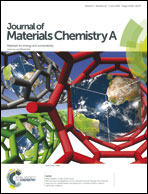Structural vs. intrinsic carriers: contrasting effects of cation chemistry and disorder on ionic conductivity in pyrochlores
Abstract
We use molecular dynamics simulations to investigate the role of cation disorder on oxygen diffusion in Gd2Zr2O7 (GZO) and Gd2Ti2O7 (GTO) pyrochlores, a class of complex oxides which contain a structural vacancy relative to the basic fluorite structure. The introduction of disorder has distinct effects depending on the chemistry of the material, increasing the mobility of structural carriers by up to four orders of magnitude in GZO. In contrast, in GTO, there is no mobility at zero or low disorder on the ns timescale, but higher disorder liberates the otherwise immobile carriers, allowing diffusion with rates comparable to GZO for the fully disordered material. We show that the cation disorder enhances the diffusivity by both increasing the concentration of mobile structural carriers and their individual mobility. The disorder also influences the diffusion in materials containing intrinsic carriers, such as additional vacancies VO or oxygen interstitials OI. While in ordered GZO and GTO the contribution of the intrinsic carriers dominates the overall diffusion of oxygen, OI in GZO contributes along with structural carriers, and the total diffusion rate can be calculated by assuming simple additive contributions from the two sources. Although the disorder in the materials with intrinsic defects usually enhances the diffusivity as in the defect-free case, in low concentrations, cation antisites AB or BA, where A = Gd and B = Zr or Ti, can act as traps for fast intrinsic defects. The trapping results in a lowering of the diffusivity, and causes a non-monotonic behavior of the diffusivity with disorder. By contrast, in the case of slow intrinsic defects, the main effect of the disorder is to liberate the structural carriers, resulting in an increase of the diffusivity regardless of the defect trapping.


 Please wait while we load your content...
Please wait while we load your content...